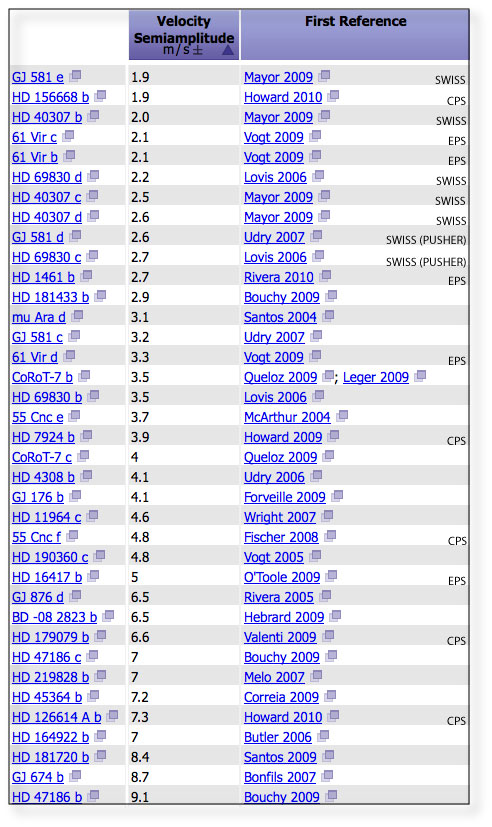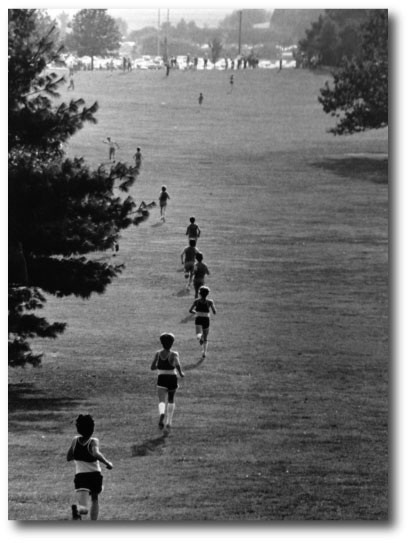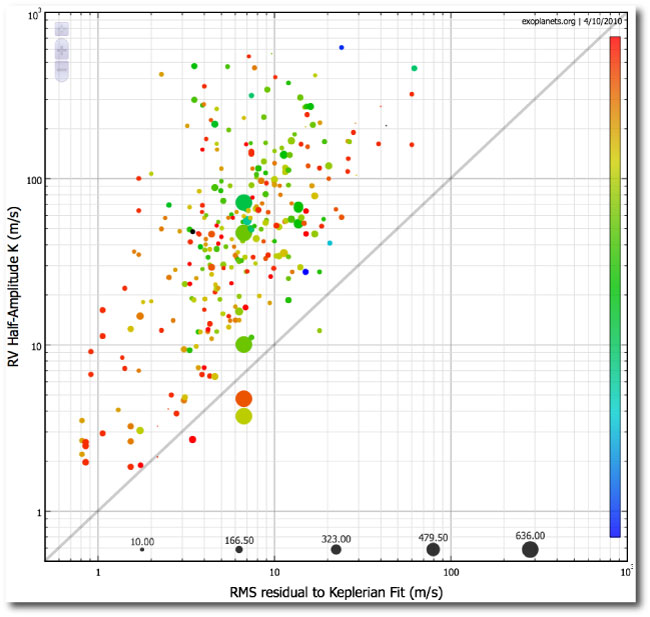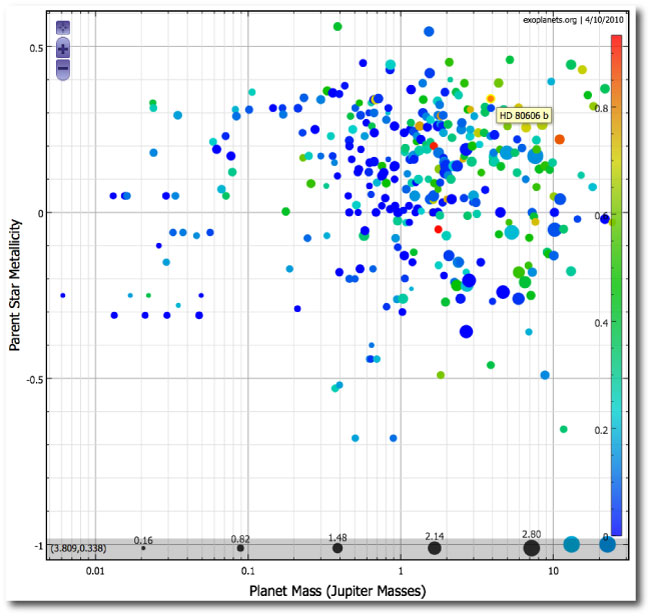Competition keeps everyone on their toes, and the exoplanet Doppler detection game is no exception.
The California Planet Search has recently done a major overhaul of their exoplanets.org website, and the results are impressive. The redesigned site is now fully interactive, and it must be seeing a lot of traffic. Certainly, I can count myself as a frequent visitor!
Perhaps the most exciting feature of the site is a plotting applet that seamlessly connects to an up-to-date and curated database of the known extrasolar planets. In the “advanced” mode, one can get very finely tuned plots that can tell interesting stories. As an example, here is a plot of RV half-amplitudes of the known planets plotted against the RMS of the residuals to the fits. The color of the points corresponds to discovery year (cool = back in the day) and the size of each point corresponds to the number of published RV data points for the planet (those five big points correspond to 55 Cancri b-f which has a very extensive data set).
The plot shows that progress comes in part from competition. As the competing Doppler surveys push to lower Ks, there has a been a trend toward decreased signal-to-noise for the detections. It looks like oklo.org posts a few years from now will likely be discussing systems with K~60 cm/sec. At that amplitude, one is plausibly talking habitable worlds.
Another interesting plot comes from plotting parent star metallicity against planet mass. As with most of the interesting diagrams, a logarithmic scaling is required. The parent star masses are keyed to the sizes of the individual points, and color is assigned to eccentricity. The software has the nice feature that a cursor placed on a dot informs you of the planet name. This plot shows the benefit of looking at lower mass stars, and it shows how the metallicity correlation is diminished as one pushes below roughly a Saturn mass (evidence, of course, for core accretion):
The exoplanets.org site also contains a very useful planet table, which is giving the competition (in this case, exoplanet.eu) a run for its money.
The question of how the world’s top Doppler teams match up in league play is something that I imagine comes up quite a bit in exoplanet-related water-cooler discussions. A suitable scoring system is therefore in order, and the tables on exoplanets.org make this a very doable proposition.
After some thought, I’ve decided to adopt the system used for cross-country running, with the K‘s of the team’s planets replacing the times of the team’s runners. (The image for this post is from a 1983 dual meet between two high school teams from Central Illinois. If you look carefully, you can see that the coach is hurling an acorn at yours truly, presumably because of the much wider-than-expected gap between runners #2 and #3.) In the exoplanet context, the cross-country scoring system encourages fluid changes of lead — one or two high-grade multiple super-Earth systems can catapult a team to the top of the board. From the wikipedia article:
When two or more teams of cross country runners compete, a score may be compiled to determine which team is the better. Points are awarded to the individual runners of eligible teams, equal to the position in which they cross the finish line (first place gets 1 point, second place gets 2 points, etc). Teams are considered ineligible to score if they have fewer than the meet’s required number of scorers, which is typically five. Only the first five runners in for a team are counted towards that team’s score; the points for these runners are summed, and the teams are ranked based on the total, with lowest being best. In the event of a tie, the rules vary depending on the competition; often the team that closes scoring first wins, though in the US NCAA ties are possible. In high school competition, if two teams tie, then the victor is decided by whose sixth runner, the first one whose score does not count, finished first.
The lowest possible score in a five-to-score match is 15 (1+2+3+4+5), achieved by a team’s runners finishing in each of the top five positions. If there is a single opposing team then they would have a score of 40 (6+7+8+9+10), which can be considered a “sweep” for the winning team. In some competitions a team’s sixth and seventh runner are scored in the overall field and are known as “pushers” or “displacers” as their place can count ahead of other runners. In the above match, if there are two non-scoring runners and they came 6th and 7th overall, the opponent’s score would be 50 (8+9+10+11+12). Accordingly, the official score of a forfeited dual meet is 15-50.
According to the above rules, there are currently three RV teams in the running. The Geneva Extrasolar Planet Search (whose planets I’ve listed with SWISS on the table), the California Planet Search (planets listed with CPS), and the Earthbound Planet Search (who I’ve marked as EPS):

The score as of this morning? SWISS 25, EPS 47, CPS 62…




The graphs are great, but is this database updated less frequently than exoplanet.eu? I don’t see CoRoT-9 listed
An amazing diversity of sites, well done!
I’ve also had thoughts along similar lines (first comment). Are the RV datasets updated in all cases, such that the newest RV reference/ dataset is next to the stellar identifier?
Hi, Greg. Thanks for the plug on the site! I hope that you’ll send us any bug reports or errors you find in the table — our heaviest users have been great at spotting typos and weird issues that somehow escaped testing. Especially if you know of any orbital fits or transit ephemerides more recent than the ones in the table (such as for good ol’ ‘606) we’d be happy to update them. Our goal is to make this maximally useful for you and other “consumers” of planet orbital parameters.
To answer the questions of the other commenters:
This database at the moment is updates somewhat less frequently than Jean Schneider’s site because we’re still training the maintainer, but we aim to have it no more than a couple of days behind once we’re running at full speed. Corot-9 is in the pipeline, and should be up a few days (I hope!).
The RV datasets on the site all come from NStED; if they haven’t ingested a dataset, it won’t be on the site. The orbits are compiled from the literature.
The RV reference listed in the database refers to the orbit listed in the database. In general, it should be the “best” orbit in the literature, which is usually the most recent. The column that Greg listed in the post is the “FIRSTREF” or the earliest peer-reviewed reference to the planet. Caution should be used here though: if a group announces a planet by press release but never publishes a paper, it won’t get into the table. If another group subsequently publishes its own data on the planet, then “FIRSTREF” won’t refer to the group that discovered the planet! Fortunately this rarely happens.
— Jason
Is it really kosher to consider the EPS and CPS teams as TWO separate teams? There’s obviously an awful lot of overlap both in people and in the facilities used (the lowest rms data for both teams seem to come from High Res on Keck). I get a score of 12.1 for the combined team vs 13.1 for the Swiss. To me (possibly only to me….) this better represents the closeness of the competition in terms of precision.
Coolstar, combining the teams give me Swiss: 25 ; California:34.
Cwmagee, I was just counting the first 5 “runners”. Still made a mistake though, I now
get the combined team at 12.1 and swiss at 11.2 and I guess I changed the rules to sum the rms rather than award points per place too!. The combined team both have members that will share the Automated Planet Finder with Steve Vogt, nor surprisingly, designing the spectrograph for it.
@jtwright
Awesome picture!